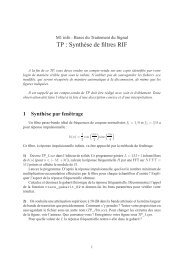Th`ese de Doctorat de l'université Paris VI Pierre et Marie Curie Mlle ...
Th`ese de Doctorat de l'université Paris VI Pierre et Marie Curie Mlle ...
Th`ese de Doctorat de l'université Paris VI Pierre et Marie Curie Mlle ...
You also want an ePaper? Increase the reach of your titles
YUMPU automatically turns print PDFs into web optimized ePapers that Google loves.
6 Mb/s. In this situation, in fact, the average number of idle connections (i.e. 6) is suffi-<br />
ciently high to exalt our dynamic allocation algorithms that reallocate unused bandwidth<br />
to active users who can take advantage of it, sending extra-traffic and generating n<strong>et</strong>work<br />
extra-revenue. With lower Off time values (i.e. with higher offered loads) the total revenue<br />
slightly <strong>de</strong>creases as less connections are idle, in average, and consequently less bandwidth<br />
is available for re-allocation.<br />
To investigate the impact on the performance of the update interval duration, we have<br />
consi<strong>de</strong>red, in the single-bottleneck scenario, different values for Tu, viz. 40sand60s.<br />
Figures 7.5 and 7.6 show, respectively, the average total load accepted in the n<strong>et</strong>work and<br />
the corresponding total extra-revenue as a function of the total load offered to the n<strong>et</strong>work<br />
for Tu =40s. Furthermore,Figures7.7and7.8show the same performance m<strong>et</strong>rics for<br />
Tu =60s.<br />
The average increase in the total accepted load, expressed as a percentage of the traffic<br />
admitted in the static allocation case, is of 14% for Tu = 40 s and 11% for Tu =60s,<br />
while for Tu = 20 s it was 24% (see Figure 7.3). These results allow to gauge the tra<strong>de</strong>-off<br />
b<strong>et</strong>ween performance improvement and overhead resulting from a more frequent execution<br />
of the allocation algorithms.<br />
We observe that an update interval value of 20 s leads to higher n<strong>et</strong>work revenue<br />
than other values. This is consistently observed across the whole range of offered loads<br />
below 90% of the maximum offered load. When the offered load increases beyond 90% of<br />
the maximum offered load, the system becomes overloa<strong>de</strong>d and the impact of the update<br />
interval value becomes negligible. Note that the best performance is achieved with Tu =20<br />
s; therefore, in the following, we choose an update interval of 20s in all n<strong>et</strong>work scenarios.<br />
In the same scenario of Figure 7.1 we then consi<strong>de</strong>red different utility functions for some<br />
sources. More specifically, the 8 connections having srk equal to 200 kb/s have associated<br />
the utility function equal to 0.5 · log(1 + x) while the 6 connections having srk equal to<br />
500 kb/s have associated the utility function of 1.5 · log(1 + x). These utility functions are<br />
60










